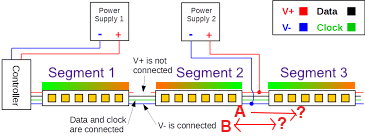Hi @Mebejedi,
One thing I see with your power injection setup here:

I’ve added power quality gradients, basically distance from power. Parts of the strip farther away from a solid power source may have lower voltages than those close to power, which is caused by voltage drop. Voltage drop is caused by resistance, and will change with current draw.
It’s possible for them to swing differently than each other, causing issues with data, and glitches, especially at higher current setups or with longer runs.
When joining 2 power zones, it’s best to inject power to the end and start pixel so they are both near their respective 5V power supply levels.
That also applies to Pixelblaze itself, you don’t want to power it at the far end of a strip away from the power source.
Thats not to say you will have data issues, but its worth testing before you commit to an install.
Also, keep in mind if you have the same power supply, you can keep the V+ lines connected. It may be easier to run wire in parallel with your strips and tap in every strip or two.